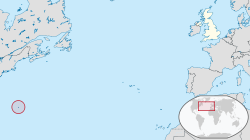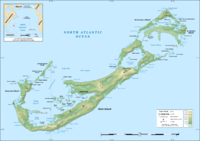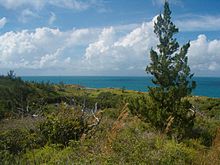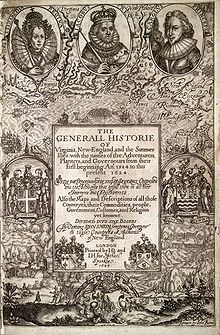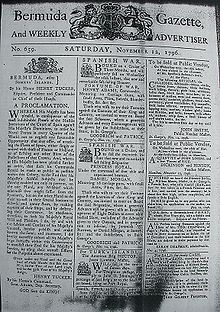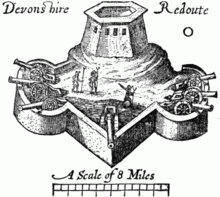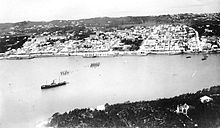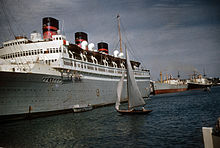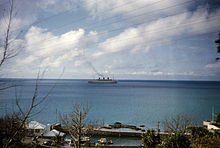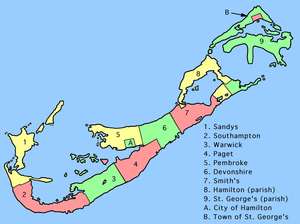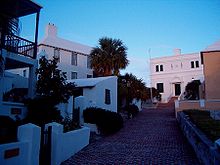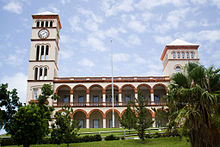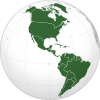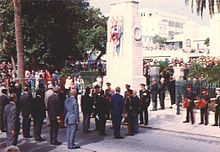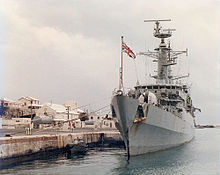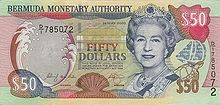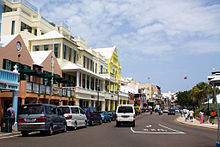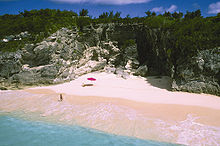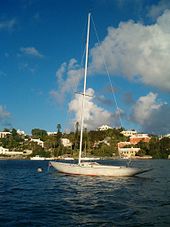
Bermuda
About this schools Wikipedia selection
SOS Children has tried to make Wikipedia content more accessible by this schools selection. Sponsoring children helps children in the developing world to learn too.
| Bermuda | ||||||
|---|---|---|---|---|---|---|
|
||||||
Motto:
|
||||||
| Anthem: God Save the Queen (official) Hail to Bermuda (unofficial) a |
||||||
|
|
||||||
| Capital | Hamilton 32°18′N 64°47′W |
|||||
| Official languages | English | |||||
| Ethnic groups (2010) |
|
|||||
| Demonym | Bermudian | |||||
| Government | Parliamentary democracy ( British Overseas Territory) |
|||||
| - | Monarch | Elizabeth II | ||||
| - | Governor | George Fergusson | ||||
| - | Premier | Craig Cannonier | ||||
| - | Responsible Ministerb ( UK) | Mark Simmonds | ||||
| Area | ||||||
| - | Total | 53.2 km2 ( 221st) 20.6 sq mi |
||||
| - | Water (%) | 27 | ||||
| Population | ||||||
| - | 2010 census | 64,268 | ||||
| - | Density | 1,275/km2 ( 9th) 3,293/sq mi |
||||
| GDP ( PPP) | 2009 estimate | |||||
| - | Total | $5.85 billion ( 149th (estimate)) | ||||
| - | Per capita | $97,000 ( 1st) | ||||
| Currency | Bermudian dollarc ( BMD) |
|||||
| Time zone | AST ( UTC–4) | |||||
| - | Summer ( DST) | ADT ( UTC–3) | ||||
| Date format | dd/mm/yyyy (AD) | |||||
| Drives on the | left | |||||
| Calling code | +1-441 | |||||
| ISO 3166 code | BM | |||||
| Internet TLD | .bm | |||||
| a. | This song is also used at international sporting events such as the Olympic Games. ( "Bermuda - London 2012 Olympics". Telegraph. July 2012. http://www.telegraph.co.uk/sport/olympics/countries/8662625/Bermuda-London-2012-Olympics.html. Retrieved 18 November 2012.) | |||||
| b. | For the Overseas Territories. | |||||
| c. | On par with United States dollar. | |||||
Bermuda (pron.: / b ɜr ˈ m juː d ə /), also referred to as the Bermudas or the Somers Isles, is a British overseas territory in the North Atlantic Ocean, located off the east coast of the United States. Its nearest landmass is Cape Hatteras, North Carolina, about 1,030 kilometres (640 mi) to the west-northwest. It is about 1,239 kilometres (770 mi) south of Cape Sable Island, Nova Scotia, and 1,770 kilometres (1,100 mi) northeast of Miami. Its capital city is Hamilton.
Bermuda was discovered in 1505 by Spanish sea captain Juan de Bermúdez, after whom the islands are named. He claimed the apparently uninhabited islands for the Spanish Empire. Although he paid two visits to the archipelago, Bermúdez was persuaded never to set foot on any of the islands by the dangerous reef surrounding them. Subsequent Spanish or other visitors are believed to have released the feral pigs that were abundant on the island when settlement began. In 1609, the Virginia Company, which had established Virginia and Jamestown on the American continent two years earlier, established a settlement on behalf of England. Initially, it was administered as an extension of Virginia by the Company until 1614, before its successor, the Somers Isles Company, took over until 1684, when the company's charter was revoked and the Crown took over administration of Bermuda. It became a British colony following the 1707 unification of the parliaments of Scotland and England, which created the Kingdom of Great Britain. After Newfoundland became part of Canada in 1949, Bermuda became the oldest (and, since the return of Hong Kong to China in 1997, the most populous) remaining British overseas territory. Its first capital, St. George's, was established in 1612 and is the oldest continuously-inhabited, English-speaking town in the New World.
Bermuda's economy is primarily made up of offshore insurance and reinsurance and tourism. Offshore finance and tourism are its two largest economic sectors. In 2005, Bermuda claimed to once have the world's highest GDP per capita, but, as Bermuda is classified as a British overseas territory rather than as an independent country, these statistics are difficult to verify. It has a subtropical climate. Bermuda makes up the eastern- and northernmost point of the so-called Bermuda Triangle, a region of sea in which, according to urban legend, a number of aircraft and surface vessels have disappeared under supposedly unexplained or mysterious circumstances. The island is prone to severe weather, including powerful hurricanes. These have, at times, led to widespread power outages.
Geography
Bermuda is a group of low-lying islands located in the Atlantic Ocean, near the western edge of the Sargasso Sea, roughly 580 nautical miles (1070 km, 670 mi) east-southeast of Cape Hatteras on the Outer Banks of North Carolina and roughly 590 nautical miles (1100 km, 690 mi) southeast of Martha's Vineyard. It is 898.2 nautical miles (1663.5 km, 1033.7 mi) from Miami, Florida, 667.374 nautical miles (1235.976 km, 768 mi) from Cape Sable Island, in Nova Scotia, Canada. The island lies due east of Fripp Island, South Carolina. It has 103 km (64 mi) of coastline. There are two incorporated municipalities in Bermuda: the City of Hamilton and the Town of St George. Bermuda is divided into nine parishes, in which there are some localities called villages, such as Flatts Village and Somerset Village.
Although usually referred to in the singular, the territory consists of 181 islands, with a total area of 53.3 square kilometres (20.6 sq mi). The largest island is Main Island, sometimes itself called Bermuda. Compiling a list of the islands is often complicated, as many have more than one name (as does the entire archipelago, which has also been known historically as La Garza, Virgineola, and the Isle of Devils. Somers Isles is often rendered "Somers Islands", or mistaken for "Summer Isles"). Despite its small land mass, there has been a tendency for place names to be repeated; there are, for example, two islands named Long Island, three bays named Long Bay (on Somerset, Main, and Cooper's Islands), two Horseshoe Bays (one in Warwick, on the Main Island, the other at Morgan's Point, formerly Tucker's Island), there are two roads through cuttings called Khyber Pass (one in Warwick, the other in St. George's Parish), and St George's Town is located on St George's Island within St George's Parish (each known as St George's), and there is a parish of Hamilton in addition to the City of Hamilton (which is in the parish of Pembroke).
Climate
Bermuda has a humid subtropical climate on the border of tropical climate. It is warmed by the nearby Gulf Stream, due to the westerlies, which carry warm, humid air eastwards over Bermuda, helping to keep winter temperatures above freezing. The climate is humid and, as a result, the summertime heat index can be high, even though mid-August temperatures rarely exceed 30 °C (86 °F). Winters are mild and windy, with average daytime temperatures in January and February around 20 °C (68 °F), although cold fronts bring Arctic air masses that can result in rapid temperature drops. Atlantic winter storms, often associated with these cold fronts, can produce powerful, gusting winds and heavy rain. Factoring in the wind chill, the felt air temperature in winter can fall below freezing, 0 °C (32 °F), even though the actual temperature rarely drops below 10 °C (50 °F). The lowest temperature recorded between 1949 and 1999 was 6.7 °C (44 °F), in February 1950.
Bermuda is very susceptible to hurricanes. Its position along the Gulf Stream means that it is often directly in the path of hurricanes recurving in the westerlies, although they usually begin to weaken as they approach the island. It is often affected by these hurricanes, although the island's small size means that direct landfalls are rare. The last hurricane to cause significant damage to Bermuda was category 3 Hurricane Fabian on 5 September 2003.
The only source of fresh water in Bermuda is rainfall, which is collected on roofs and catchments (or drawn from underground lenses) and stored in tanks. Each dwelling usually has at least one of these tanks forming part of its foundation.
The average annual temperature of the sea is 73.1 °F (22.8 °C), from 65.4 °F (18.6 °C) in February to 82.8 °F (28.2 °C) in August.
| Climate data for Hamilton – capital of Bermuda | |||||||||||||
|---|---|---|---|---|---|---|---|---|---|---|---|---|---|
| Month | Jan | Feb | Mar | Apr | May | Jun | Jul | Aug | Sep | Oct | Nov | Dec | Year |
| Record high °C (°F) | 25.4 (77.7) |
26.1 (79.0) |
26.1 (79.0) |
27.2 (81.0) |
30 (86.0) |
32.2 (90.0) |
33.1 (91.6) |
33.9 (93.0) |
33.2 (91.8) |
31.7 (89.0) |
28.9 (84.0) |
26.7 (80.0) |
33.9 (93.0) |
| Average high °C (°F) | 20.4 (68.7) |
19.9 (67.8) |
20.3 (68.6) |
21.6 (70.8) |
24.1 (75.4) |
27 (80.6) |
29.2 (84.6) |
29.8 (85.7) |
28.8 (83.8) |
26.3 (79.4) |
23.6 (74.5) |
21.4 (70.6) |
24.4 (75.9) |
| Daily mean °C (°F) | 18.2 (64.8) |
17.7 (63.9) |
18 (64.4) |
19.3 (66.7) |
22 (71.6) |
24.9 (76.8) |
26.7 (80.0) |
27.2 (80.9) |
26.2 (79.1) |
23.9 (75.0) |
21.2 (70.1) |
19 (66.2) |
22 (71.6) |
| Average low °C (°F) | 16.1 (60.9) |
15.5 (59.9) |
15.7 (60.2) |
16.9 (62.5) |
19.9 (67.8) |
22.8 (73.0) |
24.1 (75.3) |
24.5 (76.1) |
23.5 (74.3) |
21.4 (70.6) |
18.7 (65.7) |
16.5 (61.7) |
19.6 (67.3) |
| Record low °C (°F) | 7.8 (46.0) |
6.7 (44.0) |
7.2 (45.0) |
8.9 (48.0) |
12.8 (55.0) |
17.8 (64.0) |
20 (68.0) |
20 (68.0) |
18.9 (66.0) |
14.4 (58.0) |
12.4 (54.3) |
10 (50.0) |
6.7 (44.0) |
| Precipitation mm (inches) | 128.5 (5.06) |
115.3 (4.54) |
110 (4.33) |
87.9 (3.46) |
82.8 (3.26) |
130.3 (5.13) |
114.6 (4.51) |
130.8 (5.15) |
129.3 (5.09) |
161.3 (6.35) |
105.4 (4.15) |
114.3 (4.50) |
1,409.7 (55.5) |
| Avg. precipitation days (≥ 0.01 inch) | 17 | 15 | 15 | 12 | 10 | 12 | 13 | 14 | 15 | 16 | 13 | 17 | 171 |
| Mean monthly sunshine hours | 155 | 145 | 155 | 240 | 248 | 270 | 279 | 279 | 240 | 186 | 180 | 124 | 2,501 |
| Source: Bermuda Weather Service, weather2travel.comfor data of sunshine hours | |||||||||||||
| Climate data for Hamilton – capital of Bermuda | |||||||||||||
|---|---|---|---|---|---|---|---|---|---|---|---|---|---|
| Month | Jan | Feb | Mar | Apr | May | Jun | Jul | Aug | Sep | Oct | Nov | Dec | Year |
| Average high °C (°F) | 20 (68) |
20 (68) |
20 (68) |
21 (70) |
23 (73) |
27 (81) |
29 (84) |
30 (86) |
28 (82) |
26 (79) |
23 (73) |
21 (70) |
24 (75) |
| Daily mean °C (°F) | 18 (64) |
17 (63) |
18 (64) |
19 (66) |
22 (72) |
25 (77) |
27 (81) |
27 (81) |
26 (79) |
24 (75) |
21 (70) |
19 (66) |
22 (72) |
| Average low °C (°F) | 16 (61) |
15 (59) |
15 (59) |
17 (63) |
20 (68) |
22 (72) |
25 (77) |
25 (77) |
24 (75) |
22 (72) |
19 (66) |
17 (63) |
20 (68) |
| Precipitation mm (inches) | 120 (4.72) |
110 (4.33) |
100 (3.94) |
80 (3.15) |
70 (2.76) |
120 (4.72) |
110 (4.33) |
120 (4.72) |
120 (4.72) |
160 (6.3) |
100 (3.94) |
110 (4.33) |
1,400 (55.12) |
| Source: Weatherbase | |||||||||||||
Flora and fauna
When discovered, Bermuda was uninhabited and mostly dominated by forests of Bermuda cedar, with mangrove marshes along its shores. Only 165 of the island's current 1000 vascular plant species are considered native, and of those 15, including the cedar, are endemic.
Many species of palm trees have been introduced to Bermuda. Coconut palms are found on Bermuda making it the furthest north location for the natural growth of this species. While coconuts grow on Bermuda, the lack of heat does not usually allow them to properly set fruit.
The only indigenous mammals of Bermuda are five species of bats, all of which also occur in the eastern United States — Lasionycteris noctivagans, Lasiurus borealis, Lasiurus cinereus, Lasiurus seminolus and Perimyotis subflavus. Other commonly known fauna of Bermuda includes its national bird, the Bermuda Petrel, and the Bermuda Rock Skink. The skink was long thought to have been the only indigenous land vertebrate of Bermuda, discounting the marine turtles that lay their eggs on its beaches. It has recently been discovered, however, that a species of terrapin, which had been assumed to have been introduced, predated the arrival of humans on the archipelago. As this species spends most of its time in brackish ponds, there is some question as to whether it negates the skink's claim to be the only indigenous "land" vertebrate.
History
Pre-settlement
Bermuda was discovered in 1505 by Spanish explorer Juan de Bermudez. It is mentioned in Legatio Babylonica, published in 1511 by historian Pedro Mártir de Anglería, and was also included on Spanish charts of that year. Both Spanish and Portuguese ships used the islands as a replenishment spot for fresh meat and water. Legends of spirits and devils, now thought to have stemmed from the callings of raucous birds (most likely the Bermuda Petrel, or Cahow) and the loud noise heard at night from wild hogs, combined with perpetual storm-wracked conditions and a surrounding ring of treacherous reefs, led to the archipelago being called the Isle of Devils, and may have contributed to the lack of any attempt at permanent settlement.
Settlement by the English
For the next century, the island is believed to have been visited frequently but not settled. After the failure of the first two English colonies in Virginia, a more determined effort was initiated by King James I of England (James VI of Scotland), who granted a Royal Charter to the Virginia Company. In 1609, a flotilla of ships left England under the Company's Admiral, Sir George Somers, and the new Governor of Jamestown, Sir Thomas Gates, to relieve the colony of Jamestown, settled two years before. Somers had previous experience sailing with both Sir Francis Drake and Sir Walter Raleigh. The flotilla was broken up by a storm, and the flagship, the Sea Venture, was wrecked off Bermuda (as depicted on the territory's coat of arms), leaving the survivors in possession of a new territory. (William Shakespeare's play The Tempest is thought to have been inspired by William Strachey's account of this shipwreck.) The island was claimed for the English Crown, and the charter of the Virginia Company was extended to include it.
Most of the survivors of the Sea Venture sailed on to Jamestown in 1610 aboard two Bermuda-built ships. Among them was John Rolfe, who left a wife (Sarah Hacker) and child buried in Bermuda before marrying Pocahontas, a daughter of Powhatan, in Jamestown. Intentional settlement of Bermuda began with the arrival of the Plough, in 1612. St George's was settled in 1612 and made Bermuda's first capital. It is the oldest continually inhabited English town in the New World.
In 1615, the colony was passed to a new company, the Somers Isles Company (The Somers Isles remains an official name for the colony, named after Admiral Somers, just as Gate's Bay and Fort Gates are named after Sir Thomas Gates), formed by the same shareholders. (Somers died on the island in 1610; although his last wish was to be buried in Bermuda, his nephew partially fulfilled that request by burying his heart and entrails in what is now Somers Garden in St. George. The rest of his body was carried back to England preserved in a rum barrel and is buried in a churchyard outside his home town of Lyme Regis.) The close ties with Virginia were commemorated even after Bermuda's separation by reference to the archipelago in many Virginian place names, such as Bermuda City, and Bermuda Hundred. The first British coins in America were struck here.
Company colony
Because of its limited land area, Bermuda has had difficulty with over-population. In the first two centuries of settlement it relied on steady human emigration to keep the population manageable. Before the American Revolution more than ten thousand Bermudians (over half of the population) emigrated, primarily to the American South, where Great Britain was displacing Spain as the dominant European imperial power. A steady trickle of outward migration continued. With seafaring being the only real industry, by the end of the 18th century at least a third of the island's manpower was at sea at any one time.
The archipelago's limited land area and resources led to the creation of what may be the earliest conservation laws of the New World. In 1616 and 1620 acts were passed banning the hunting of certain birds and young tortoises.
In 1649, the English Civil War raged and King Charles I was beheaded in Whitehall, London. The execution resulted in the outbreak of a Bermudian civil war; it was ended by militias. This created a strong sense of devotion to the crown for the majority of colonists and it forced those who did not swear allegiance, such as Puritans and independents, into exile in the Bahamas.
In the 17th century, the Somers Isles Company suppressed shipbuilding, as it needed Bermudians to farm in order to generate income from the land. Agricultural production met with only limited success, however. The Bermuda cedar boxes used to ship tobacco to England were reportedly worth more than their contents. The colony of Virginia far surpassed Bermuda in both quality and quantity of tobacco produced. Bermudians began to turn to maritime trades relatively early in the 17th century, but the Somers Isles Company used all its authority to suppress turning away from agriculture. This interference led to the islanders demanding, and receiving, the revocation of the Company's charter in 1684, the Company itself being dissolved.
Maritime economy
After the dissolution of the Somers Isle Company, Bermudians rapidly abandoned agriculture for shipbuilding, replanting farmland with the native juniper ( Juniperus bermudiana, called Bermuda cedar) trees that grew thickly over the whole island. Establishing effective control over the Turks Islands, Bermudians deforested their landscape to begin the salt trade that became the world's largest and remained the cornerstone of Bermuda's economy for the next century.
Bermudian sailors relied on more than salt, however. They vigorously pursued whaling, privateering, and the merchant trade. Vessels sailed the normal shipping routes, but were required to engage an enemy vessel no matter the size or strength, and as a result many ships were destroyed.
The Bermuda sloop became highly regarded for speed and maneuverability. The Bermuda sloop HMS Pickle, one of the fastest vessels in the Royal Navy, brought the news of the victory at Trafalgar and the death of Admiral Nelson back to England.
Bermuda and the American War of Independence
American independence was to lead to tremendous changes for Bermuda. Prior to the war, with no useful landmass or natural resources, Bermuda was largely ignored and left to its own devices by the London government.
Due to those same limitations, before the war, in an effort to exploit all of the opportunities it could obtain by its maritime trade, Bermuda had played a role out of all proportion to its size in the development of the trans-Atlantic English and British Empires.
It had played key roles in settling new colonies, especially in the American South, and had used its merchant fleet and a web of expatriate Bermudian merchants to dominate trade through a number of American Atlantic Seaboard ports and the West Indies. Bermudians fished for cod on the Grand Banks, and were involved in the lumber industry in Central America. Most importantly, they dominated the North American salt trade with de facto control of the Turks Islands.
Had Bermuda not been so remote from the American coastline, and the Royal Navy not enjoyed supremacy on that part of the Atlantic, it would almost certainly have been the fourteenth colony to join the rebellion. The close economic, family, and historical ties ensured Bermudians were strongly sympathetic with the rebels at the start of the War, supplying them illegally with ships, salt and gunpowder. As the war progressed, economic realities caused Bermudians, if not to sympathise with the Crown, then to seize the economic opportunities available to them, chief of which was privateering against the Americans.
The end of the war, however, was to cause profound change in Bermuda, though some of those changes would take decades to crystallise. Following the war, with the build up of Naval and military forces in Bermuda, the primary leg of the Bermudian economy became defence infrastructure. Even after tourism began later in the 19th century, Bermuda remained, in the eyes of London, a base more than a colony, and this led to a change in the political dynamics within Bermuda as its political and economic ties to Britain were strengthened, and its independence on the world stage was diminished. The war had removed Bermuda's primary trading partners, the American colonies, from the empire, and dealt a harsh blow to Bermuda's merchant shipping trade, which would be worsened by the deforestation of Bermuda, as well as by the advent of metal ships and steam propulsion. During the course of the following American War of 1812 (which some Americans dubbed the Second War of Independence), the primary market for Bermuda's Turks salt disappeared as the Americans developed their own sources. Control of the Turks finally passed to the Bahamas in 1619.
By the end of the 19th century, except for the presence of the naval and military facilities, Bermuda was thought of by non-Bermudians and Bermudians alike as a quiet, rustic backwater, completely at odds with the role it had played in the development of the English-speaking Atlantic world, a change that had begun with American independence.
Fortress Bermuda
After the American Revolution, the Royal Navy began improving the harbours and in 1811 started building the large dockyard on Ireland Island, in the west of the chain, to serve as its principal naval base guarding the western Atlantic Ocean shipping lanes. To guard it, the British Army built up a large Bermuda Garrison, and heavily fortified the archipelago. During the War of 1812 between Britain and the United States, the British attacks on Washington, D.C. and the Chesapeake (which prompted the writing of The Star-Spangled Banner) were planned and launched from Bermuda, where the headquarters of the Royal Navy's North American Station had recently been moved from Halifax, Nova Scotia.
In 1816, James Arnold, the son of Benedict Arnold, fortified Bermuda's Royal Naval Dockyard against possible U.S. attacks. Today, the National Museum of Bermuda, which incorporates the "Maritime Museum", occupies the Keep of the Royal Naval Dockyard, including the Commissioner's House, and exhibits artefacts of the base's military history.
As a result of Bermuda's proximity to the southeastern U.S. coast, it was regularly used by Confederate States blockade runners during the American Civil War to evade Union naval vessels and bring desperately needed war goods to the South from England. The old Globe Hotel in St George's, which was a centre of intrigue for Confederate agents, is preserved as a museum open to the public.
Anglo-Boer War
During the Anglo-Boer War (1899–1902), 5,000 Boer prisoners of war were housed on five islands. The placement of the Boer Prisoners of War were according to their views of the war. "Bitterenders" (Afrikaans: Bittereinders) who refused to pledge allegiance to the British Crown were interned on Darrell's Island and closely guarded. Other islands such as Morgan's Island held 884 men, including 27 officers, Tucker's Island held 809 Boer Prisoners of War, Burt's Island – 607, and Port's Island held 35.
The New York Times reported an attempted mutiny by Boer Prisoners of War en route to Bermuda and that martial law was enacted on Darryll's Island, in addition to the escape of three Boer Prisoners of War to mainland Bermuda as well as an escape by a young Boer soldier from Bermuda to New York on the steamship Trinidad.
The most famous prisoner was Fritz Joubert Duquesne, who escaped from Bermuda, settled in the USA and became a spy for Imperial Germany during the First World War. He claimed to have sabotaged and sunk HMS Hampshire, on which Lord Kitchener (the head of the British Army, who had been a key architect of the Boer defeat in the Second Boer War)died in 1916. Lord Kitchener's brother, Lt. Gen. Sir Walter Kitchener, had been the Governor of Bermuda from 1908 until his death in 1912, and his son, Major Hal Kitchener (with his partner, Major Hemming), both First World War aviators, bought Hinson's Island, formerly part of the Boer POW camp (it housed teenaged prisoners from 1901 to 1902), where he built his home and operated an aviation company.
Economic and political development
In the early 20th century, as modern transport and communication systems developed, Bermuda became a popular destination for American, Canadian and British tourists arriving by sea. In addition, the Smoot-Hawley Tariff Act enacted by the United States in 1930 to protect its own economy, and subsequently cut off Bermuda's once-thriving agricultural export trade (primarily lilies and fresh vegetables to the U.S.), spurring the overseas territory to develop its tourist industry.
After several failed attempts, in 1930 the first aeroplane reached Bermuda. A Stinson Detroiter seaplane flying from New York, it had to land in the ocean once because of darkness and then again to refuel. Navigation and weather forecasting improved in 1933 when the Royal Air Force established a station at Bermuda and operated float planes from the harbour in coordination with the British fleet. In 1936 Luft Hansa began to experiment with seaplane flights from Berlin via the Azores with continuation to New York City. In the late 1930s, Imperial Airways and Pan American World Airways began operating scheduled flying-boat airline services from New York and Baltimore to Darrell's Island, Bermuda. In 1948, regularly scheduled commercial airline service by land-based aeroplanes began to Kindley Field (now L.F. Wade International Airport), helping tourism to reach its peak in the 1960s–1970s. By the end of the 20th century, international business had supplanted tourism as the dominant sector of Bermuda's economy (see Economy of Bermuda).
The Royal Naval Dockyard, and the attendant military garrison continued to be an important component of Bermuda's economy until the mid-20th century. In addition to considerable building work, the armed forces needed to source food and other materials from local vendors. Beginning in World War II, U.S. military installations also were located in Bermuda (see "Military" section below and Military of Bermuda).
Universal adult suffrage and the development of a two-party political system occurred in the 1960s. Before universal suffrage, adopted as part of Bermuda's Constitution in 1967, voting was based on property ownership (see "Politics" section, below, and Politics of Bermuda). On 10 March 1973, then-Governor of Bermuda Richard Sharples was assassinated by local Black Power militants during a period of civil unrest in the 1970s.
Parishes and municipalities
Bermuda is divided into nine parishes and two municipalities.
Bermuda's nine parishes:
- Devonshire
- Hamilton
- Paget
- Pembroke
- St George's
- Sandys
- Smith's
- Southampton
- Warwick
Bermuda's two incorporated municipalities:
- Hamilton (city)
- St George's (town)
Bermuda's two informal villages:
- Flatts Village
- Somerset Village
Despite their names, Jones Village (in Warwick), Cashew City (St. George's), Claytown (Hamilton), Middle Town (Pembroke) and Tucker's Town (St. George's) are merely neighborhoods; Dandy Town and North Village are sports clubs and Harbour View Village is a small public housing development.
Politics
Executive authority in Bermuda is vested in the monarch and is exercised on her behalf by the Governor. The governor is appointed by the Queen on the advice of the British Government. The current governor is George Fergusson; he was sworn in on 23 May 2012. There is also a Deputy Governor (currently David Arkley JP). Defence and foreign affairs remain the responsibility of the United Kingdom, which also retains responsibility to ensure good government. It must approve any changes to the Constitution of Bermuda. Bermuda now exists as an overseas territory of Britain, but it is the oldest British colony. In 1620, a Royal Assent granted Bermuda limited self-governance, thus making the Parliament of Bermuda the fifth oldest in the world, behind only the Parliament of the United Kingdom, the Tynwald of the Isle of Man, the Althing of Iceland and Sejm of Poland. Of all of these, it is the only one that has been in continuous existence since 1620.
The Constitution of Bermuda came into force on 1 June 1967 and was amended in 1989 and 2003. The head of government is the premier. A cabinet is nominated by the premier and appointed officially by the governor. The legislative branch consists of a bicameral parliament modelled on the Westminster system. The Senate is the upper house consisting of 11 members appointed by the governor on the advice of the premier and the leader of the opposition. The House of Assembly, or lower house, has 36 members elected by the eligible voting populace in secret ballot to represent geographically defined constituencies.
Elections must be called at no more than five-year intervals. The most recent took place on December 17, 2012. Following this election, the One Bermuda Alliance took power, with Craig Cannonier succeeding Paula Cox, of the Progressive Labour Party, as Premier.
There are few accredited diplomats in Bermuda. The United States maintains the largest diplomatic mission in Bermuda, comprising both the United States Consulate and the U.S. Customs and Border Protection Services at the L.F. Wade International Airport. The current U.S. Consul General is Robert Settje, who took office in August, 2012. Given that the United States is by far Bermuda's largest trading partner (providing over 71% of total imports, 85% of tourist visitors, and an estimated $163 billion of U.S. capital in the Bermuda insurance/re-insurance industry alone, and the fact that an estimated 5% of Bermuda residents are U.S. citizens, which represents 14% of all foreign-born persons), American diplomatic presence is seen as an important element in the Bermuda political landscape.
Role in international relations
As Bermuda is not a country, but a British Overseas Territory, it has no seat in the United Nations and is represented by Britain in matters of foreign affairs. To promote its economic interests abroad, Bermuda maintains representative offices in cities such as London and Washington D.C.
Bermuda's proximity to the United States has made it the site of past summit conferences between British Prime Ministers and U.S. Presidents. The first summit was held in December 1953, at the insistence of Prime Minister Winston Churchill (who had previously visited Bermuda as Prime Minister in January 1942, during the Second World War, following December 1941 conferences with US President Franklin Roosevelt, in the weeks after the Japanese attack on Pearl Habour), to discuss relations with the Soviet Union during the Cold War. Participants at the conference included Churchill, U.S. President Dwight D. Eisenhower and French Premier Joseph Laniel. In 1957, a second summit conference was held; this time British Prime Minister Harold Macmillan arrived earlier than President Eisenhower, to make it clear that they were meeting on British territory, as tensions were still high regarding the previous year's conflict over the Suez Canal. Macmillan returned in 1961 for the third summit with President John F. Kennedy. The meeting was called to discuss Cold War tensions arising from construction of the Berlin Wall. The most recent summit conference in Bermuda between the two powers occurred in 1990, when British Prime Minister Margaret Thatcher met U.S. President George Bush.
Direct meetings between the President of the United States and the Premier of Bermuda have been rare. The most recent meeting was on 23 June 2008, between Premier Ewart Brown and President George W. Bush. Prior to this, the leaders of Bermuda and the United States had not met at the White House since a 1996 meeting between Premier David Saul and President Bill Clinton.
Asylum offered to four former Guantánamo detainees
On 11 June 2009, four Uyghurs who had been held in extrajudicial detention in the United States Guantánamo Bay detention camp, in Cuba were deported to Bermuda. The four men were among 22 Uyghurs who claimed to be refugees, who were captured in 2001 in Pakistan after fleeing the American aerial bombardment of Afghanistan. They were accused of training to assist Taliban's military. They were cleared as safe for release from Guantánamo in 2005 or 2006. But U.S. domestic law prohibited deporting them back to China, their country of citizenship, because the U.S. government determined that China was likely to violate their human rights.
In September 2008, the men were cleared of all suspicion and Judge Ricardo Urbina in Washington ordered their release. However, domestic opposition to their admittance to the United States was very strong and, until Bermuda and Palau agreed to accept them in June 2009, the U.S. failed to find a home for them.
The secret bilateral discussions that led to prisoner transfers between the U.S. and the devolved Bermuda government sparked diplomatic ire from the United Kingdom, which was not consulted on the move despite Bermuda being a British territory. The British Foreign Office issued the following statement: "We've underlined to the Bermuda Government that they should have consulted with the United Kingdom as to whether this falls within their competence or is a security issue, for which the Bermuda Government do not have delegated responsibility. We have made clear to the Bermuda Government the need for a security assessment, which we are now helping them to carry out, and we will decide on further steps as appropriate."
Caribbean Community
Despite lying nearer to Canada than the Caribbean, Bermuda became an associate member of the Caribbean Community (CARICOM) in 2003.
This is a socio-economic bloc of nations in or near the Caribbean, such as the Co-operative Republic of Guyana, the Republic of Suriname, and Belize in Central America as full members. The Turks and Caicos Islands, an associate member of CARICOM, and the Commonwealth of The Bahamas, a full member of CARICOM, are in the Atlantic, but near to the Caribbean. Other nearby nations or territories, such as the United States, are not members (although the US Commonwealth of Puerto Rico has observer status, and the US Virgin Islands announced in 2007 they would seek ties with CARICOM). Bermuda, at roughly a thousand miles from the Caribbean Sea, has little trade with, and little economically in common with, the region, and joined primarily to strengthen cultural links.
Among some scholars, "the Caribbean" can be a socio-historical category, commonly referring to a cultural zone characterised by the legacy of slavery and the plantation system. It embraces the islands and parts of the neighboring continent—and may be extended to include the Caribbean Diaspora overseas.
Although Bermuda began as an extension of Virginia and has long had close ties with the US Atlantic Seaboard and Canadian Maritimes as well as the UK, the last century has seen considerable immigration from the West Indies (the last century and a half has also seen continued immigration from Portuguese Atlantic islands, although these immigrants faced greater difficulties in making their immigration permanent, as they lacked British citizenship, mostly spoke no English, and required renewal of work permits in order to remain beyond an initial period. From the 1950s onwards, immigration laws were relaxed, allowing increased immigration from Britain and Canada, which many Black politicians accused the government of using as a ploy to counter the West Indian immigration that had already been continuing for decades, and which had resulted in a shift of the balance of Blacks to Whites in Bermuda).
The PLP, the party in government when the decision to join CARICOM was made, has been dominated for decades by West Indians (the prominent roles of West Indians among Bermuda's black politicians and labour activists predating party politics in Bermuda, as exemplified by as Dr. E. F. Gordon), and the descendants of West Indians (such as Dame Lois Browne-Evans), and places a strong emphasis on Bermuda's connection with the West Indies, though many Bermudians, Black or White, without West Indian forebears objected strenuously (despite the political power achieved by West Indian-Bermudians, West Indians have long been subjected to the animosity of ethnic-Bermudians, Black and White, who derided them as "jump-ups").
Opinion polls conducted by Bermudian newspapers, The Royal Gazette and The Bermuda Sun, showed clear majorities of Bermudians as opposed to joining CARICOM. The UBP, which had been in Government from 1968 to 1998, objected on the basis that joining CARICOM was detrimental to Bermuda's interests: Other than large-scale West Indian immigration to Bermuda throughout the 20th century, Bermuda's trade with the West Indies is negligible, its primary economic partners being the USA, Canada, and UK (there are not even direct air or shipping links); CARICOM is moving towards a single economy, which Bermuda would not be able to form part of without disastrous effects on its own economy; the Caribbean islands are generally competitors to Bermuda's already ailing tourism industry; participation in CARICOM would involve considerable investment of money and the time of government officials that could more profitably be spent elsewhere.
|
||||||||||||||
Military
Once known as "the Gibraltar of the West" and "Fortress Bermuda", the defence of Bermuda remains the responsibility of the British government. For the first two centuries of settlement, the most potent armed force operating from Bermuda was its merchant shipping fleet, which turned to privateering at every opportunity. After the American Revolutionary War, Bermuda became the Royal Navy's Western Atlantic headquarters, before which the Bermuda government had maintained militia for the defence of the colony. Once the Royal Navy established a base and dockyard defended by regular soldiers, however, these militias became superfluous and were disbanded following the War of 1812. At the end of the 19th century, the colony did raise volunteer units to form a reserve for the military garrison.
Due to its isolated location in the North Atlantic Ocean, Bermuda was vital to the Allies' war effort during both world wars of the 20th century, serving as a marshalling point for trans-Atlantic convoys, as well as a naval air base. By the Second World War, both the Royal Navy's Fleet Air Arm and the Royal Air Force were operating Seaplane bases on Bermuda.
In May 1940, the U.S. requested base rights in Bermuda from the United Kingdom, but British Prime Minister Winston Churchill was initially unwilling to accede to the American request without getting something in return. In September 1940, as part of the Destroyers for Bases Agreement, the United Kingdom granted the U.S. base rights in Bermuda. Bermuda and Newfoundland were not originally included in the agreement, but both were added to it, with no war material received in exchange. However, one of the terms of the agreement was that the airfield the U.S. Army built would be used jointly by the U.S. and the UK (which it was for the duration of the war, with RAF Transport Command relocating there from Darrell's Island in 1943). Construction began in 1941 of two airbases consisting of 5.8 km² (2¼ sq mi, 1,400 acres) of land, largely reclaimed from the sea. For many years, Bermuda's bases were used by U.S. Air Force transport and refuelling aircraft and by U.S. Navy aircraft patrolling the Atlantic for enemy submarines, first German and, later, Soviet. The principal installation, Kindley Air Force Base on the eastern coast, was transferred to the U.S. Navy in 1970 and redesignated Naval Air Station Bermuda. As a naval air station, the base continued to host both transient and deployed USN and USAF aircraft, as well as transitioning or deployed Royal Air Force and Canadian Forces aircraft.
The original NAS Bermuda on the west side of the island, a seaplane base until the mid-1960s, became the Naval Air Station Bermuda Annex and provided optional anchorage and/or dockage facilities for transiting U.S. Navy, U.S. Coast Guard and NATO vessels, depending on size.. An additional U.S. Navy compound known as Naval Facility Bermuda (NAVFAC Bermuda), a SOSUS station, was located to the west of the Annex near a Canadian Forces communications facility. Although leased for 99 years, U.S. forces withdrew in 1995, as part of the wave of base closures following the end of the Cold War.
Canada, which had operated a war-time naval base, HMCS Somers Isles, on the old Royal Navy base at Convict Bay, St George's, also established a radio-listening post at Daniel's Head, in the West End of the islands during this time.
In the 1950s, after the end of World War II, the Royal Naval dockyard and the military garrison were closed. A small Royal Navy supply base, HMS Malabar, continued to operate within the dockyard area, supporting transiting Royal Navy ships and submarines until it, too, was closed in 1995, along with the American and Canadian bases.
Bermudians served in the British armed forces during both World War I and World War II. After the latter, Major-General Glyn Charles Anglim Gilbert, Bermuda's highest ranking soldier, was instrumental in developing the Bermuda Regiment. A number of other Bermudians and children of Bermudians had preceded him into senior ranks, including Bahamian-born Admiral Lord Gambier, and Bermudian-born Royal Marines Brigadier Harvey, who, when promoted to that rank at age 39, following his wounding at the Anzio landings, became the youngest-ever Royal Marine Brigadier. The Cenotaph in front of the Cabinet Building (in Hamilton) was erected in tribute to Bermuda's Great War dead (the tribute was later extended to Bermuda's Second World War dead) and is the site of the annual Remembrance Day commemoration.
Today, the only military unit remaining in Bermuda, other than naval and army cadet corps, is the Bermuda Regiment, an amalgam of the voluntary units originally formed toward the end of the 19th century. Although the Regiment's predecessors were voluntary units, the modern body is formed primarily by conscription in which balloted males are required to serve for three years, two months part-time, once they turn 18.
Economy
Since switching from the Bermudian pound in 1970, Bermuda's currency has been the Bermudian dollar, which is pegged to the US dollar similar to Hong Kong. US notes and coins are used interchangeably with Bermudian notes and coins within the islands for most practical purposes; however, banks levy an exchange rate fee for the purchase of US dollars with Bermudian dollars. Bermudian notes carry the image of HM Queen Elizabeth II. The Bermuda Monetary Authority is the issuing authority for all banknotes and coins, as well as being responsible for the regulation of financial institutions. There is a permanent exhibition of Bermuda notes and coins at the Royal Naval Dockyard Museum.
According to the Bermuda Government's Economic Statistics Division, Bermuda's GDP was $5.85 billion in 2007, or $91,477 per-capita, giving Bermuda the highest GDP per capita in the world.
The affordability of housing has become a prominent issue during Bermuda's business peak in 2005 but has softened with the decline of Bermuda's real estate prices. The CIA World Factbook lists the average cost of a house in June 2003 as $976,000, while real estate agencies have claimed that this figure had risen to between $1.6 million and $1.845 million by 2007, though such high figures have been disputed.
Bermuda is an offshore financial centre, which results from its minimal standards of business regulation/laws and direct taxation on personal or corporate income. Bermuda has one of the highest consumption taxes in the World & taxes all imports in lieu of an income tax system. Bermudas's consumption tax is equivalent to local income tax to local residents and funds necessary Governmental and infrastructural costs to live in a civilized society. The local tax system depends upon import duties, payroll taxes and consumption taxes. The legal system is derived from that of the United Kingdom, with recourse to English courts of final appeal. However, foreign private individuals cannot easily open bank accounts or subscribe to mobile phone or internet service.
Government employment, off-shore business and tourism are the largest sectors of Bermuda's economy. However, in September 2009, it was reported that a growing number of companies were moving from Bermuda to Ireland as part of a search for "a more stable environment".
Large numbers of leading international insurance companies operate in Bermuda. Those internationally owned and operated businesses that are physically based in Bermuda—of which there are around four hundred—are represented by the Association of Bermuda International Companies (ABIC). In total, over 15,000 exempted or international companies are currently registered with the Registrar of Companies in Bermuda most of which hold no office space or employees.
There are four hundred securities listed on the stock exchange, of which almost three hundred are offshore funds and alternative investment structures attracted by Bermuda's regulatory environment. The Exchange specialises in listing and trading of capital market instruments such as equities, debt issues, funds (including hedge fund structures) and depository receipt programmes.
The BSX is a full member of the World Federation of Exchanges and is located in an OECD member nation. It also has Approved Stock Exchange status under Australia's Foreign Investment Fund (FIF) taxation rules and Designated Investment Exchange status by the UK's Financial Services Authority.
Tourism is Bermuda's second largest industry, with the island attracting over one-half million visitors annually, of whom more than 80% are from the United States. Other significant sources of visitors are from Canada and the United Kingdom. Tourists arrive either by cruise ship or by air at L.F. Wade International Airport, the only airport on the island.
Demographics
Bermuda's 2010 Census put Bermuda's population at 64,237. The ethnic makeup of Bermuda is 54% black, 31% white, 8% multiracial, 4% Asian, and 4% other races. Native Bermudians made up 67% of the population, compared 29% non-natives, however, 79% of residents had Bermudian status. A significant segment of the white population is of Portuguese ancestry (10%), the result of immigration from Portuguese islands (especially the Azores) during the past 160 years.
Some islanders, especially in St David's, trace their ancestry to Native Americans, and many more may be ignorant of such ancestry. Hundreds were shipped to Bermuda, possibly from as far as Mexico. The best known examples were the Algonquian peoples who were exiled from the New England colonies and sold into slavery in the 17th century, notably in the aftermaths of the Pequot War, and King Philip's War, but some are have believed to come from as far away as Mexico.
Several thousand expatriate workers, principally from the UK, Canada, the West Indies, South Africa and the U.S., also reside in Bermuda, primarily engaged in specialised professions such as accounting, finance, and insurance. Others are employed in various trades, such as hotels, restaurants, construction, and landscaping services. Of the total workforce of 38,947 persons in 2005, government employment figures stated that 11,223 (29%) were non-Bermudians.
Education
The Bermuda Education Act 1996 requires that only three categories of schools can operate in the Bermuda Education system:
- An aided school has all or a part of its property vested in a body of trustees or board of governors and is partially maintained by public funding or, since 1965 and the desegregation of schools, has received a grant-in-aid out of public funds.
- A maintained school has the whole of its property belonging to the Government and is fully maintained by public funds.
- A private school, not maintained by public funds and which has not, since 1965 and the desegregation of schools, received any capital grant-in-aid out of public funds. The private school sector consists of six traditional private schools, two of which are religious schools, and the remaining four are secular with one of these being a single gender school and another a Montessori school. Also, within the private sector there are a number of home schools which must be registered with the government and receive minimal government regulation. The only boys' school opened its doors to girls in the 1990s and in 1996, one of the aided schools became a private school.
Prior to 1965, the Bermuda school system was racially segregated and when the desegregation of schools was enacted in 1965, two of the formally maintained "white" schools and both single-sex schools opted to become private schools. The rest became part of the public school system and were either aided or maintained.
At present there are 26 schools in the Bermuda Public School System, 18 of which are primary schools, five are middle schools, two senior schools and one special school. There is also an Alternative Programme provided for students with behavioural challenges who cannot function in the public mainstream. There are one aided primary schools, two aided middle schools and one aided senior school.
For higher education, the Bermuda College offers various associate degrees and other certificate programmes. Bermuda does not have any four-year colleges or universities.
In May 2009, Bermudian Government's application was approved to become a contributory member of the University of the West Indies (UWI). Bermuda's membership is slated to allow Bermudian students to enter the University at an agreed upon subsidised rate possibly as early as the 2009/2010 school year. UWI also agrees that their Open Campus (online degree courses) would become open to Bermudian students in the future, with Bermuda becoming the 13th country to have access to the Open Campus.
Health care
The Bermuda Hospitals Board operates the King Edward VII Memorial Hospital, located in Paget Parish, and the Mid-Atlantic Wellness Institute, located in Devonshire Parish.
Culture
Bermuda's culture is a mixture of the various sources of its population; Native American, Spanish-Caribbean, Irish, and Scots cultures were evident in the 17th century, though ultimately eclipsed by the dominant Anglo-Saxon culture. Today, the only language other than English that is spoken by any substantial part of the population is Portuguese, following one hundred and sixty years of immigration from Portuguese Atlantic islands (primarily the Azores, though also from Madeira and the Cape Verde Islands). There are strong British influences, together with Afro-Caribbean ones. A second wave of immigration from the West Indies was sustained throughout the 20th century, although, unlike the Blacks who immigrated from there as indentured servants, or who were imported as slaves in the 17th century, the more recent arrivals have mostly come from English-speaking countries (albeit, most of the West Indian islands whose populations now speak English were then part of the Spanish Empire). This new infusion of West Indians has both accelerated social and political change, and diversified Bermuda's culture.
In the 20th century, a large number of books were written and published locally, though few were aimed at a wider market than Bermuda (most of these being scholarly reference books, rather than creative writing). Expatriate Bermudian author Ernest Graham Ingham wrote at the turn of the 19th and 20th Centuries. One Bermudian novelist, Brian Burland, has achieved a degree of success and acclaim internationally, although the first notable, and historically important, book credited to a Bermudian was the History of Mary Prince, a slave narrative by a Bermudian woman, Mary Prince, which helped to end slavery in the British Empire. Bermuda's proximity to the United States, as well as its origin as part of Virginia, means that many aspects of US culture are reflected in, or incorporated into, Bermudian culture. Many non-Bermudian writers have also made Bermuda their home, or have had homes here, including A. J. Cronin and F. Van Wyck Mason, who wrote on Bermudian subjects.
Bermuda has produced, or been home to, actors such as Oona O'Neill, Earl Cameron, Diana Dill, Lena Headey, Will Kempe, and most famously, Michael Douglas and Catherine Zeta-Jones. Other film and television personalities who were born, or have lived, in Bermuda include producer Arthur Rankin, Jr., and cartoonist and Muppet man Michael Frith.
Arts
West Indian musicians introduced Calypso music when Bermuda's tourist industry was expanded with the increase of visitors brought by post Second World War aviation. While Calypso music appealed more to the visitors than to the locals, Reggae has been embraced by many Bermudians since the 1970s with the influx of Jamaican immigrants.
Bermuda's early literary history was largely limited to non-Bermudian writers commenting on the island. These included John Smith's The Generall Historie of Virginia, New-England, and the Summer Isles (1624), and Edmund Waller's poem, "Battle of the Summer Islands" (1645).
Music and dance are important in Bermuda. Noted musicians have included local icons The Talbot Brothers, who performed for many decades both in Bermuda and the United States, and appeared on Ed Sullivan's televised variety show, jazz pianist Lance Hayward, singer-songwriter Heather Nova and her brother, Mishka, tenor Gary Burgess, classical musician and conductor Kenneth Amis, and more recently, dancehall artist Collie Buddz.
The dances of the colourful Gombey Dancers, seen at many events, are heavily influenced by African, Caribbean, Native American and British cultural traditions.
Bermudan Gina Swainson was crowned " Miss World" in 1979.
Every year, Bermuda hosts an international film festival which shows many independent films. One of the festival's founders is film producer and director Arthur Rankin, Jr., co-founder of the Rankin/Bass production company.
Bermuda watercolours painted by local artists are sold at various galleries, and elaborately hand-carved cedar sculptures are another specialty. One such 7 ft (2.1 m) sculpture created by Bermudian artisan Chesley Trott is on display at the airport's baggage claim area. Local artwork may also be viewed at several galleries around the island. Alfred Birdsey was one of the more famous and talented water colourists; his impressionistic landscapes of Hamilton, St George's and the surrounding sailboats, homes, and bays of Bermuda are world-renowned.
Main sights
Bermuda's pink sand beaches and clear, cerulean blue ocean waters are popular with tourists and many of Bermuda's hotels are located along the south shore of the island. In addition to its beaches, there are a number of sightseeing attractions. Historic St George's is a designated World Heritage Site. Scuba divers can explore numerous wrecks and coral reefs in relatively shallow water (typically 30–40 ft/9–12 m in depth) with virtually unlimited visibility. Many nearby reefs are readily accessible from shore by snorkellers, especially at Church Bay.
Bermuda's most popular visitor attraction is the Royal Naval Dockyard, which includes the Bermuda Maritime Museum. Other attractions include the Bermuda Aquarium, Museum and Zoo, Bermuda Underwater Exploration Institute, the Botanical Gardens, lighthouses, and the Crystal Caves with its impressive stalactites and underground saltwater pools.
It is not possible to rent a car on the island; however, visitors can hire scooters for use as private transport, or use public transport.
Sports
Bermuda's national cricket team participated in the Cricket World Cup 2007 in the West Indies. Their most famous player is a 130 kilograms (290 lb) police officer named Dwayne Leverock. But India defeated Bermuda and set a record of 413 runs in a One-Day International (ODI) and therefore Bermuda were knocked out of the World Cup. Also very well-known is David Hemp, a former captain of Glamorgan in English first class cricket. The annual "Cup Match" cricket tournament between rival parishes St George's in the east and Somerset in the west is the occasion for a popular national holiday.
In 2007, Bermuda hosted the 25th PGA Grand Slam of Golf. This 36-hole event was held on 16–17 October 2007, at the Mid Ocean Club in Tucker's Town. This season ending tournament is between only four golfers – the winners of the Masters, U.S. Open, British Open and PGA Championship. The event returned to Bermuda again in 2008 and 2009. Bermudian Quinn Talbot was once the World one-armed golf champion.
The Government announced in 2006 that it will provide substantial financial support to Bermuda's cricket and football teams. Bermuda's most prominent footballers include Clyde Best, Shaun Goater, The legendary Kevin De Silva, Reggie Lambe, Sam Nusum and Ralph Bean. In 2006, the Bermuda Hogges were formed as the nation's first professional football team in order to raise the standard of play for the Bermuda national football team. The team plays in the United Soccer Leagues Second Division.
Sailing, fishing and equestrian sports are popular with both residents and visitors alike. The prestigious Newport–Bermuda Yacht Race is a more than 100-year old tradition. In 2007, the 16th biennial Marion-Bermuda yacht race occurred. A sport unique to Bermuda is racing the Bermuda Fitted Dinghy. International One Design racing also originated in Bermuda.
At the 2004 Summer Olympics, Bermuda competed in sailing, athletics, swimming, diving, triathlon and equestrian events. In those Olympics, Bermuda's Katura Horton-Perinchief made history by becoming the first black female diver to compete in the Olympic Games. Bermuda has had one Olympic medallist, Clarence Hill, who won a bronze medal in boxing. Bermuda also competed in Men's Skeleton at the 2006 Winter Olympics in Turin, Italy. Patrick Singleton placed 19th, with a final time of 1:59.81. Jillian Teceira competed in the Beijing Olympics in 2008. It is also tradition for Bermuda to march in the Opening Ceremony in Bermuda shorts, regardless of the summer or winter Olympic celebration. Bermuda also competes in the biennial Island Games, which it will host in 2013.
Bermuda has developed a proud Rugby Union community. The Bermuda Rugby Union team won the 2011 Caribbean championships – defeating Guyana in the final – they previously beat The Bahamas and Mexico to take the crown. Rugby 7's is also played, with four rounds scheduled to take place in the 2011–2012 season. The Bermuda 7's team competed in the 2011 Las Vegas 7's, defeating the Mexican team. There are four clubs on the island: (1) Police (2) Mariners (3) Teachers (4) Renegades. There is a men's and women's competition – current league champions are Police (Men) (winning the title for the first time since the 1990s) and Renegades (women's). Games are currently played at Warwick Academy. Bermuda u/19 team won the 2010 Caribbean Championships.
The New York Yankees of Major League Baseball held Spring Training in Bermuda in 1913. Yankee owner Frank J. Farrell was said to be so pleased with the experience that he considered moving the Yankee training camp to Bermuda permanently.



